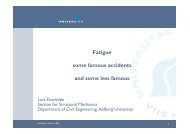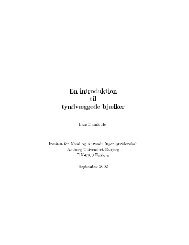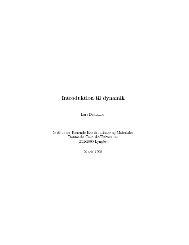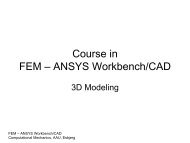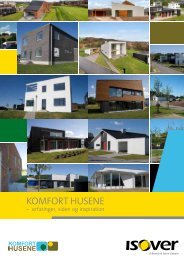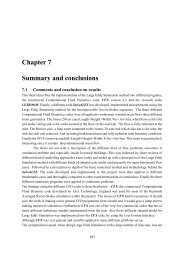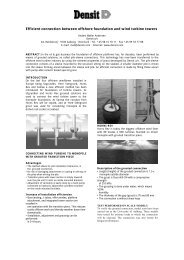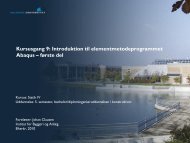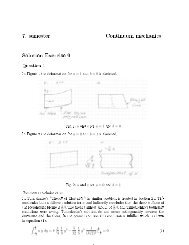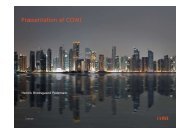Peter V. Nielsen, Li Rong and Inés Olmedo The IEA Annex 20 Two ...
Peter V. Nielsen, Li Rong and Inés Olmedo The IEA Annex 20 Two ...
Peter V. Nielsen, Li Rong and Inés Olmedo The IEA Annex 20 Two ...
- No tags were found...
Create successful ePaper yourself
Turn your PDF publications into a flip-book with our unique Google optimized e-Paper software.
<strong>Peter</strong> V. <strong>Nielsen</strong>, <strong>Li</strong> <strong>Rong</strong> <strong>and</strong> Inés <strong>Olmedo</strong><strong>The</strong> <strong>IEA</strong> <strong>Annex</strong> <strong>20</strong> <strong>Two</strong>-Dimensional Benchmark Test for CFD PredictionsISBN 978-975-6907-14-6Clima <strong>20</strong>10, 10 th REHVA World Congress
<strong>The</strong> <strong>IEA</strong> <strong>Annex</strong> <strong>20</strong> <strong>Two</strong>-Dimensional Benchmark Test for CFD Predictions<strong>Peter</strong> V. <strong>Nielsen</strong> 1 , <strong>Li</strong> <strong>Rong</strong> 1 <strong>and</strong> Inés <strong>Olmedo</strong> 21 Aalborg University, Denmark2 Córdoba University, SpainCorresponding email: pvn@civil.aau.dkSUMMARYThis paper describes a benchmark test which can be used for tests of CFD predictions ofroom air distribution. <strong>The</strong> benchmark describes a box-like room with a supply slot along theside wall. Laser-Doppler measurements <strong>and</strong> hot-wire measurements are given for comparisonwith the obtained CFD predictions both for isothermal flow <strong>and</strong> for nonisothermal flow. <strong>The</strong>benchmark is defined on a web page, which also shows about 50 different benchmark testswith studies of e.g. grid dependence, numerical schemes, different source codes, differentturbulence models, RANS or LES, different turbulence levels in a supply opening, study oflocal emission <strong>and</strong> study of airborne chemical reactions. <strong>The</strong>refore the web page is also acollection of information which describes the importance of the different elements of a CFDprocedure.<strong>The</strong> benchmark is originally developed for test of two-dimensional flow, but the paper alsoshows results for three-dimensional steady flow.INTRODUCTION<strong>The</strong> <strong>IEA</strong> <strong>Annex</strong> <strong>20</strong> two-dimensional test case was developed by the participants of the <strong>Annex</strong><strong>20</strong> work in 1990 as a benchmark [1]. Figure 1 shows the dimensions of the geometry.Figure 1. <strong>The</strong> two-dimensional benchmark test.<strong>The</strong> air distribution in the benchmark corresponds to the situation in a room with a slot inlet.<strong>The</strong> dimensions <strong>and</strong> flow conditions are the following: L/H = 3.0, h/H = 0.056 <strong>and</strong> Re = 5000,
where L, H, h, Re are length, height, slot height <strong>and</strong> Reynolds number, respectively.Velocities are measured in a model with W/H = 1.0 [2], <strong>and</strong> streaklines are photographed in amodel with W/H = 4.7, see figure 2, [3].Figure 2. Streaklines obtained by photographing metaldehyde particle flow. <strong>The</strong> particles areilluminated in the symmetry plane of the room.<strong>The</strong> velocity profiles for the inlet slot are also given in [1], <strong>and</strong> the following conditionsshould be used in most benchmark testsk o = 1.5 (0.04 · u o ) 2 , ε o = k o 1.5 /l o <strong>and</strong> l o = h/10 (1)where k o is turbulent kinetic energy in the supply opening, ε o is the dissipation, <strong>and</strong> l o is thelength scale.<strong>The</strong> benchmark test is divided into an isothermal case, 2D1, as described above, <strong>and</strong> anonisothermal case, 2D2, where the temperature distribution is measured along a horizontalplane in the room with heat released along the whole floor, figure 3 [3]. A small Archimedesnumber <strong>and</strong> a high velocity ensure an almost isothermal flow, <strong>and</strong> the temperature distributioncorresponds to a concentration distribution from an even distributed source along the floor. Anonisothermal test with high Archimedes number <strong>and</strong> restricted penetration of the plane walljet into the room is also introduced [1]. Those measurements are based on Scwenke’sexperiments [4].Figure 3. Position of measurement points for temperature distribution in the benchmark test.APPLICATION OF THE BENCHMARK<strong>The</strong> benchmark is located together with three other benchmarks on the web page:www.cfd-benchmarks.com<strong>The</strong> other benchmarks are about computer simulated manikins. <strong>The</strong>y deal with mixingventilation <strong>and</strong> displacement ventilation, thermal comfort <strong>and</strong> personalized ventilation.
About 50 different applications of the <strong>IEA</strong> <strong>Annex</strong> <strong>20</strong> two-dimensional benchmark (madebetween 1974 <strong>and</strong> now) can be found on the web page. This gives the possibility to compare aprediction with other authors’ results (other turbulence models, other numerical schemes,different inlet conditions, etc.). <strong>The</strong> basic knowledge behind the benchmark test has thus beenexp<strong>and</strong>ed during the years <strong>and</strong> made the benchmark test more useful. A few examples arediscussed in the following sections.Early predictionsFigure 4 shows some early two-dimensional predictions based on the vorticity-streamfunction equations, ω-ψ, <strong>and</strong> on the RANS equations, [3] <strong>and</strong> [5] as well as predictions basedon RANS equations with a one equation turbulence model, [6].Figure 4. Early predictions of the velocity profile at x/H = 2.0 with different sets of transportequations, <strong>and</strong> different turbulence models.Different numerical schemesFigure 5 shows a set of predictions based on a low Reynolds number k-ε model (the LRNmodel), [7]. <strong>The</strong> results are compared at two different vertical sections. <strong>The</strong> recirculating flowis well predicted in the simulations, although the magnitude of the counter flow is slightlyunderestimated. <strong>The</strong> maximum velocity in the occupied zone is accurate with respect to bothlocation <strong>and</strong> magnitude.
Figure 5. Velocity profiles <strong>and</strong> turbulent kinetic energy predicted by a LRN model.2It is possible to compare the measured RMS value u'with the square root of the turbulentkinetic energy k because the flow can be considered as a flow with wall jet profiles ( k ~21.1 u ' ). <strong>The</strong> figure shows that the predicted level of turbulence is in good agreement withthe measurements.Large Eddy Simulations, LES, can be used to obtain detailed information on turbulence,which can not be achieved by the traditional time-averaged turbulence models. <strong>The</strong> turbulence2is predicted in details, <strong>and</strong> it is possible to make a direct prediction of u ' . Figure 6 showssome early predictions by Davidson <strong>and</strong> <strong>Nielsen</strong> [8]. It was difficult to get sufficientintegration time for the calculation of u <strong>and</strong>2u ' .Figure 6. Time-averaged velocity <strong>and</strong> turbulence intensity in the symmetry plane predicted byLES.AB
Figure 7. Probability density function of ufloor at x/H = 1.0. See [8].<strong>The</strong> probability density function of uuouoclose to the ceiling at x/H = 2.0, <strong>and</strong> close to theclose to the ceiling at x/H = 2.0 has a well-definedmean velocity, <strong>and</strong> the velocity fluctuates around the mean velocity in a symmetricaldistribution, figure 7A, while the flow close to the floor at x/H = 1.0 is asymmetric (has askewness) with a probability of both a negative <strong>and</strong> a positive velocity, figure 7B.Different turbulence models<strong>Two</strong>-dimensional steady state predictions with different turbulence models indicate somedifferences, especially in two of the corners as shown in figure 8, [9]. <strong>The</strong> grid is identical inall four cases, which means that the difference in the flow can be ascribed to the turbulencemodels used to predict the two-dimensional flow. <strong>The</strong> predictions with the SST model showespecially a large recirculating flow in the occupied zone below the supply slot 0 < x/H < 1.5.Similar results have been obtained by Voigt [10]. It is not possible to fully exclude this flowpattern from the observation of the streaklines shown by photos as in figure 2, but it does notcorresponds to the Laser-Doppler measurements in the benchmark.Figure 8. <strong>Two</strong>-dimensional isothermal <strong>and</strong> steady state simulations of the <strong>Annex</strong> <strong>20</strong> 2Dbenchmark test. Four different turbulence models are used together with the RANS equations.THREE-DIMENSIONAL STEADY STATE PREDICTIONS<strong>The</strong> benchmark was originally selected for the simulation of steady two-dimensional flows forthe <strong>IEA</strong> <strong>Annex</strong> <strong>20</strong> work back in 1990. <strong>The</strong> flow in the benchmark was considered to be twodimensional<strong>and</strong> steady, but three-dimensional unsteady flows could, at least in principle,occur. LES predictions indicate an asymmetric probability density function at the floor at x/H= 1.0 with a probability of both negative <strong>and</strong> positive velocities, figure 7B, <strong>and</strong> measurementsin rooms with L/H ≥ 4.0 <strong>and</strong> W/H = 4.7 do also show unsteady flow at the floor for 0 < x/H
when different turbulence models are used. Figure 9 shows the flow in the symmetry plane ofthe room for the k-ε model <strong>and</strong> the SST model. <strong>The</strong> three-dimensional prediction with the k-εmodel looks similar to the two-dimensional predictions in figure 8, while the threedimensionalprediction with the SST model is slightly different from the two-dimensionalversion in figure 8. <strong>The</strong> large recirculating flow in the occupied zone below the supply slot isreduced compared to the flow in the two-dimensional case. This change in the flow towardsthe flow predicted by the other turbulence models could be a result of having threedimensionalflow, but it could not be fully excluded that the use of a different grid might havesome influence. (<strong>The</strong> two-dimensional predictions, figure 8, are made in a structured grid,while the three-dimensional predictions in figure 9 <strong>and</strong> 10 are made in an unstructured grid).k-ε modelk-ω modelSST modelFigure 9. Three-dimensional isothermal <strong>and</strong> steady state simulations of the <strong>Annex</strong> <strong>20</strong> 2Dbenchmark test. Three different turbulence models are used together with the RANSequations.<strong>The</strong> difference between a two-dimensional k-ω prediction <strong>and</strong> a three-dimensional k-ωprediction of the flow can be explained by looking at the flow in the occupied zone. Figure 10show the three-dimensional steady flow predicted by the k-ω model. <strong>The</strong> flow in the middleplane is very different from the flow close to the side wall. A horizontal section in theoccupied zone shows how the recirculating flow in the middle plane has a higher velocitythan the flow close to the side walls. <strong>The</strong> flow in the middle of the room therefore creates twohorizontal circulations in the region below the supply opening, which ensures a fully verticalrecirculation in the middle plane. <strong>The</strong> flow is unsymmetric in the room, although the room issymmetric.<strong>The</strong> measured flow in the benchmark, [1], does not show this large difference between thevelocity distribution in the middle plane <strong>and</strong> the velocity distribution at a distance of 0.1Wfrom the side wall.Flow in middle planeFlow close to side wall (0.1W fromside wall)
Flow in horizontal plane in theoccupied zone (0.5·h above floor)Figure 10. Three-dimensional isothermal <strong>and</strong> steady state simulations of the <strong>Annex</strong> <strong>20</strong> 2Dbenchmark test with a k-ω turbulence model solved together with the RANS equations.A study by Susin et al. [11] using three-dimensional flow concludes that the k-ε modelperformed best compared to the RNG k-ε model <strong>and</strong> the k-ω model, <strong>and</strong> that the mostsignificant differences between calculated <strong>and</strong> experimental velocity profiles were also foundalong the floor.CONCLUSIONS<strong>The</strong> two-dimensional benchmark test, called the “<strong>IEA</strong> 2D test case” was defined in 1990 to beused in the <strong>IEA</strong> <strong>Annex</strong> <strong>20</strong> work.<strong>The</strong> benchmark is defined on a web page, so it can also be used in other CFD work. <strong>The</strong>rehave been a very large number of papers that use this geometry, <strong>and</strong> about 50 works arereported on the web page. This gives the possibility to compare a prediction with otherauthors’ results (other turbulence models, other numerical schemes, different inlet conditions,etc.). <strong>The</strong> basic knowledge behind the benchmark test has thus been exp<strong>and</strong>ed during theyears <strong>and</strong> made the benchmark test more useful.Predictions by different turbulence models show some variation in the obtained streamlinepattern. Especially the k-ω SST model gives a flow different from the flow obtained by theother models.<strong>The</strong> benchmark was originally selected for the simulation of steady two-dimensional flow,<strong>and</strong> the flow in the benchmark was considered to be two-dimensional <strong>and</strong> steady, but threedimensionalunsteady flow could, at least in principle, occur.Predictions by a steady state three-dimensional flow show streamline pattern similar to thetwo-dimensional predictions, but the SST model introduces a change in the flow which isslightly towards the flow predicted by the other turbulence models.An analysis of the three-dimensional flow predicted by the k-ω model shows a largedifference of the flow in the middle plane compared to the flow in a plane close to the sidewall. This difference could not be confirmed by the measurements in the benchmark.REFERENCES1. <strong>Nielsen</strong>, P V. 1990. Specification of a <strong>Two</strong>-Dimensional Test Case, Aalborg University, <strong>IEA</strong><strong>Annex</strong> <strong>20</strong>: Air Flow Patterns within Buildings.2. Restivo, A M. 1979. Turbulent Flow in Ventilated Rooms, PhD thesis, Imperial College,London.
3. <strong>Nielsen</strong>, P V. 1974. Strømningsforhold i luftkonditionerede lokaler, PhD thesis, TechnicalUniversity of Denmark. (English translation: Flow in Air Conditioned Rooms, 1976).4. Schwenke, H. 1975. Über das Verhalten ebener horizontaler Zuluftstrahlen im begrenztenRaum, Luft- und Kältetechnik, Nr. 5, Dresden.5. <strong>Nielsen</strong>, P V, Restivo, A, <strong>and</strong> Whitelaw, J H. 1978. <strong>The</strong> Velocity Characteristic of VentilatedRooms, Journal of Fluid Engineering, Vol. 100, pp. 291-298.6. Davidson, L <strong>and</strong> Olsson, E. 1987. Calculation of Some Parabolic <strong>and</strong> Elliptic Flows Using aNew One-Equation Turbulence Model, Proc. 5 th . International Conference on NumericalMethods in Laminar <strong>and</strong> Turbulent Flow, Montreal.7. Skovgaard, M <strong>and</strong> <strong>Nielsen</strong>, P V. 1991. Simulation of Simple Test Case, Case 2D1, Internalreport for the International Energy Agency, <strong>Annex</strong> <strong>20</strong>, Aalborg University, ISSN 0902-7513R9131.8. Davidson, L <strong>and</strong> <strong>Nielsen</strong>, P V. 1996. Large Eddy Simulation of the Flow in a Three-Dimensional Ventilated Room, Proc. of Roomvent’96, Yokohama.9. <strong>Rong</strong>, L <strong>and</strong> <strong>Nielsen</strong>, P V. <strong>20</strong>08. Simulation with Different Turbulence Models in an <strong>Annex</strong> <strong>20</strong>Room Benchmark Test Using Ansys CFX 11.0, DCE Technical Report No. 46, AalborgUniversity.10. Voigt, L K. <strong>20</strong>00. Comparison of Turbulence Models for Numerical Calculation of Airflow inan <strong>Annex</strong> <strong>20</strong> Room, Department of Energy Engineering, Technical University of Denmark, ET-AFM <strong>20</strong>00-01, ISBN 87-7475-225-1.11. Susin, R M, <strong>Li</strong>ndner, G A, Mariani, V C, <strong>and</strong> Mendonca, K C. <strong>20</strong>09. Evaluating the Influence ofthe Width of Inlet Slot on the Prediction of Indoor Airflow: Comparison with ExperimentalData, Building <strong>and</strong> Environment, 44, pp. 971-986.



